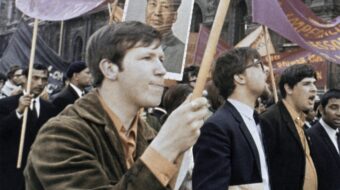Recent stories coming out of China have exposed a dark underside to its export-driven industrialization program. Apple and many other electronic device companies rely upon extremely labor-intensive production provided at a number of manufacturing clusters, the largest of which is Foxconn, a Taiwan based multinational corporation.
Foxconn has 13 factories in nine Chinese cities, more than in any other country. Its largest factory worldwide is in Longhua, Shenzhen, where up to 450,000 workers are employed at the Longhua Science and Technology Park, a walled campus sometimes referred to as “iPod City.” It covers about 1.16 square miles, includes 15 factories, worker dormitories, a swimming pool, a fire brigade, its own television network (Foxconn TV) and a downtown complete with a grocery store, bank, restaurants, bookstore and hospital. While some workers live in surrounding towns and villages, most live and work inside the complex. A quarter of the employees live in the dormitories, and many of them work 12-hour days for 6 days each week.
The Foxconn manufacturing complex became the focus of worldwide attention when it was reported that between January and November 2010, eighteen Foxconn employees attempted suicide with eighteen deaths. The suicides prompted 20 Chinese universities to compile a report on Foxconn, which they decried as a labor camp. Long working hours, discrimination against mainland Chinese workers by their Taiwanese coworkers, and a lack of working relationships have all been cited as potential causes.
The studies also suggested that the Foxconn deaths may have been a product of economic conditions external to the Foxconn complex itself. In China in 2010, there were several strikes at other high-profile manufacturers in China. The Chinese university studies note that a fundamental decline in the surplus Chinese labor supply that has powered its labor-intensive “factory of the world” development strategy, especially in export products, is the underlying cause of labor market distortions and abuses.
China at the turning point
In developing countries where the excess labor in the subsistence agricultural sector is fully absorbed into the modern sector, further capital accumulation cannot find labor unless it begins to increase wages. This point is called the “Lewisian turning point,” after Nobel Laureate Arthur Lewis. Of course, the history of capitalism does not witness corporations reacting wisely to these changes. Rather, their impulse is to intensify the work process with longer hours and speedup. What results instead is an intensification of the class struggle – waves of strike actions and political upheaval as workers reject the increasingly inhumane conditions.
The class struggle hit Foxconn management like a hammer in the head. Chinese manufacturing now must confront moving away from labor-intensive strategies toward automation and higher skilled occupations to match the emerging demographics. In response to the suicides and strikes, Foxconn increased wages for its Shenzhen factory workforce by 25 percent. However, in typical corporate narcissistic culture, Foxconn also absurdly demanded that employees sign no-suicide pledges, as well as documents promising that they and their descendants would not sue the company as a result of death, self-injury or suicide.
Class struggle under socialism?
Some readers may ask, “How can there be such abuses, and class conflicts, under socialism? Doesn’t socialism promise and end to class conflict, and create a classless society?” Among the many misconceptions regarding socialism is the notion that social and economic classes can be willed into existence or non-existence by just wishing, or voting, or legislating, that it be just so, without regard to objective conditions of technology, natural and labor resources, and many other factors.
The Chinese revolution overthrew a putrid and corrupt regime headed by feudal lords and early capitalists. The revolution of 1949 was led by mass movements of the working and peasant classes. They took over the leadership of society when the ancient regime collapsed in the chaos and aftermath of World War II, and did indeed set forth to bring into being a classless society. Capitalist and feudal rights were denied any franchise and most industrial and agricultural property was confiscated by the state for redistribution. There was initial success and rapid growth, but soon the country ran headlong into the reality of the great economic, technological and cultural chasms between backwardness and the conditions of relative abundance Karl Marx outlined as the requirement of sustaining classless social relations. The “Great Leap Forward” under Mao Zedong collapsed under the weight of these contradictions with very difficult consequences and suffering for China.
But the Chinese socialist experiment did not collapse. Instead it retreated, economically, to a position advocated by Vladimir Lenin as early as 1920, where the working class and peasant coalition would retain political power and the “commanding heights” of the economy while re-introducing capitalist relations and advanced firm management techniques in the developing parts of the economy. The consequence for China has been the fastest and most sustained development rate of any large country in the history of the world – a staggering effort that has single-handedly reversed world poverty rates, even in the global depression.
But you can’t have capitalism, and social progress for working people, without class struggle. That struggle will propel the Chinese working class by the multitudes of millions to the full realization of the promise of their revolution – as it will for all those who do the work of the world.











